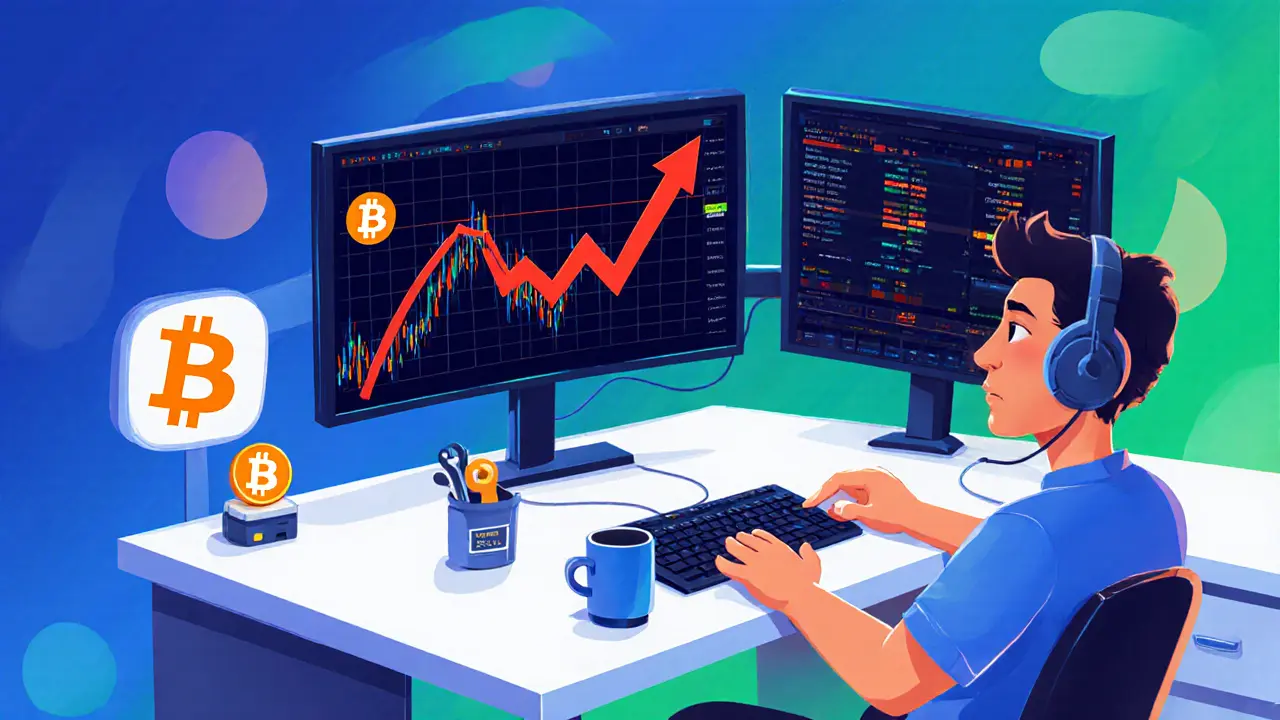
- 22 Jan 2025
- Elara Crowthorne
- 23
Bitcoin Futures Strategy Calculator
Strategy Analysis
Recommended Strategy:
Potential Profit/Loss:
Risk Level:
High Risk
Aggressive short-term trades with high leverage. Suitable for experienced traders.
Medium Risk
Balanced approach combining technical indicators and position sizing.
Low Risk
Conservative hedging and long-term positioning with stop-losses.

Key Takeaways
- Use directional trades for simple bets, but back them with stop‑losses and tight position sizing.
- Short‑ and long‑hedge futures protect existing spot exposure during volatile swings.
- Choose exchanges with maker fees under 0.03% and leverage that matches your risk tolerance.
- Combine RSI, Bollinger Bands, and volume cues to time entry and exit on perpetual swaps.
- Automated bots and AI‑driven signals can capture high‑frequency edges, but require rigorous backtesting.
Bitcoin’s price can swing 10% in a single session, and perpetual contracts keep that volatility alive 24/7. If you want to profit-or protect your holdings-without actually owning the coin, mastering Bitcoin futures strategies is a must. Below you’ll find a hands‑on playbook that covers everything from basic long/short bets to advanced AI‑enabled arbitrage, all anchored in real‑world numbers from the biggest exchanges.
Bitcoin is a decentralized digital currency that launched in 2009. Its price history is marked by rapid rallies and deep corrections, making it a prime candidate for futures contracts. A Bitcoin futures are derivative agreements that let traders lock in a future price for Bitcoin, either to speculate on direction or to hedge existing exposure. The first regulated contracts appeared on the Chicago Mercantile Exchange (CME) in December2017, bringing institutional credibility to crypto derivatives.. Since then, platforms like Binance offer perpetual swap contracts that never expire, allowing continuous position management. Understanding how these pieces fit together is the foundation for any profitable strategy.

23 Comments
Listen, if you're not already leveraging delta‑neutral cross‑margin hedges, you're basically leaving free money on the table.
The guide's emphasis on RSI and Bollinger Bands is solid, but you should also be stacking calendar spreads to capture term structure decay.
Remember, funding rate arbitrage on perpetuals can shave off a few basis points daily – integrate it into your risk matrix.
And for the love of all things crypto, stop ignoring order‑book depth; liquidity throttling is the silent killer.
Hey folks, great rundown here! For anyone new to futures, start by sizing your position so that a 5% move only risks 1‑2% of your capital.
Use the CME index as a reference for settlement risk and then overlay on‑chain volume spikes to confirm momentum.
When you combine a 20‑period EMA with Bollinger Band squeezes, you get a nice entry filter that cuts down false breakouts.
Also, keep a tight stop‑loss and a trailing stop once you’re in profit – that way you lock in gains while the market runs.
Finally, consider diversifying across perpetual swaps and quarterly contracts; the variance in funding rates can add a small but steady edge.
Keep your leverage under 25x, use stop‑losses, and don’t trade on impulse.
It is evident that many traders overlook the paramount importance of liquidity depth, which inevitably leads to catastrophic drawdowns. One must rigorously monitor order‑book imbalances before any high‑leverage entry. Failure to do so is tantamount to financial negligence. The guide’s omission of this factor is unacceptable. 🚨
In the grand tapestry of derivative markets, Bitcoin futures represent a fascinating confluence of speculation and hedging, where the prudent participant must engage both mathematically rigorous analysis and philosophical contemplation.
One might argue that the very notion of risk is a social construct, yet the immutable ledger of blockchain forces us to confront volatility with unflinching clarity.
The interplay between funding rates and market sentiment creates an arbitrage corridor, which, if exploited judiciously, can yield modest returns irrespective of directional bias.
However, the perils of over‑leverage remain ever‑present; a sudden swing of ten percent can decimate a position leveraged beyond the prudent threshold.
Thus, it is advisable to calibrate exposure such that the notional value does not exceed a modest fraction of one's total equity.
Furthermore, the utilization of both CME‑settled contracts and perpetual swaps affords a diversification of settlement risk, which is a cornerstone of robust portfolio construction.
In summation, the synthesis of technical indicators, order‑book depth analysis, and mindful position sizing constitutes the bedrock of a sustainable futures strategy.
Guys, I totally get how intimidating futures can feel, especially when you see those crazy 10% swings on the chart. But the truth is, you can tame that beast by starting small and focusing on the basics – like setting a stop‑loss at a level where you’re comfortable losing a tiny slice of your account.
When you first hop onto a platform, play around with the demo mode; treat it like a sandbox where you can experiment with RSI, Bollinger Bands, and even a few moving averages without risking real money.
Once you have a feel for how the market reacts to news and volume spikes, you can gradually increase your position size, but always keep your leverage under control – 10x or 20x is usually enough for most retail traders.
Remember, consistency beats occasional big wins; a steady 1‑2% gain per trade compounds beautifully over time.
And hey, celebrate each small victory – it builds confidence and keeps you motivated to keep learning and improving.
Stick to low leverage and always use a stop loss
Yo the guide is missing the real killer – liquidity crunches during news spikes you get slashed if you ain’t watching the order book enough
Don't ignore how funding rates shift, they can eat your profits fast
Esteemed colleagues, I wish to underscore the indispensable role of rigorous back‑testing when deploying any futures strategy; without statistical validation, one merely gambles with capital rather than engages in informed speculation. Moreover, the integration of maker‑fee optimization can materially enhance net returns, especially on high‑frequency frameworks. I recommend employing a minimum of 10,000 simulated trades to assess drawdown characteristics before live deployment. 😊
Hey, just a quick heads up – when you’re settin up your leverge, make sure the exchange offers low taker fees, otherwise you’ll be losing money on every trade. Also, keep an eye on your margin ratio – if it looks red, cut size or add collaterl.
Love the guide! 🙌 Just remember to stay chill and not chase every hype wave – the market loves to punish over‑eager traders. Keep your risk low and your vibes high! 😎
Oh sure, because ignoring funding rates and order‑book depth has worked out great for everyone else, right? 🙄 If you think you can just hop on 100x leverage and magically surf the volatility, you’re in for a rude awakening.
American traders dominate the market, and we should stick to platforms that support USD‑based contracts to keep the flow of capital within our borders.
Indeed, a disciplined approach to position sizing is paramount; one must never exceed a risk exposure of 1‑2% per trade, regardless of market euphoria; this principle safeguards against catastrophic loss, especially during sudden spikes in volatility; moreover, integrating multi‑layered stop‑loss mechanisms can further fortify your strategy.
Embarking on Bitcoin futures trading can feel like stepping into a grand philosophical experiment where each trade is a hypothesis about market behavior.
First, recognize that risk is not a mere number but a reflection of your emotional tolerance and long‑term goals.
Second, adopt a systematic framework: define entry criteria, set explicit stop‑loss levels, and pre‑determine profit targets.
Third, leverage should be treated as a magnifier of both potential gain and potential loss; keep it modest until you have proven consistency.
Fourth, incorporate diverse indicators – combine trend‑following tools like the 50‑EMA with volatility filters such as Bollinger Band width.
Fifth, monitor funding rates across exchanges; arbitraging these can provide a steady edge independent of price direction.
Sixth, back‑test your strategy over multiple market cycles to ensure robustness against both bull and bear regimes.
Seventh, maintain a trading journal documenting rationale, emotions, and outcomes; this introspective practice fuels continual improvement.
Eighth, allocate only a fraction of your total capital to futures; preserve a core holding of BTC for long‑term appreciation.
Ninth, stay aware of macro‑economic catalysts – regulatory news, macro data, and institutional flows can abruptly shift sentiment.
Tenth, manage leverage exposure in relation to position size; a 20x leveraged position on a 5% move can wipe out your account if unprotected.
Eleventh, employ trailing stops once in profit to lock in gains while allowing the trade to run.
Twelfth, diversify across contract types – combine perpetual swaps with quarterly futures to balance funding cost and expiration risk.
Thirteenth, keep fees in mind; high‑frequency strategies demand platforms with minimal maker‑taker spreads.
Finally, cultivate patience and humility; the market will always have lessons for those willing to learn, and success is a marathon, not a sprint.
Wow, that was an epic rundown – I especially appreciate the note on funding‑rate arbitrage; have you tried layering that with a volatility‑scaled position size? It could add a sweet layer of depth to the strategy.
Most of these “best practices” are just corporate hype – the real money is made by going opposite to the crowd and taking insane leverage when everyone is scared.
From a systemic perspective, the integration of cross‑margin collateral optimization with delta‑neutral straddle constructions can significantly enhance risk‑adjusted returns in the Bitcoin futures arena.
By dynamically rebalancing the gamma exposure in response to implied volatility shifts, traders can capture the convexity premium inherent in perpetual swaps.
Moreover, leveraging statistical arbitrage across disparate exchanges mitigates counterparty risk while exploiting transient funding differentials.
It is imperative to employ a high‑frequency data feed to accurately gauge order‑book microstructure, as latency arbitrage remains a potent source of alpha in ultra‑liquid markets.
Ultimately, a holistic approach that synthesizes quantitative signal generation, robust execution algorithms, and rigorous capital allocation frameworks will outpace naïve directional bets.
Friends, I want to emphasize that the mental game is just as crucial as the technical execution when navigating Bitcoin futures.
Developing a disciplined routine – such as reviewing your trade plan each morning, setting clear risk parameters, and taking scheduled breaks – can prevent emotional fatigue.
When you encounter a losing streak, remember it’s an opportunity to reassess and refine your strategy rather than a personal failure.
Celebrate small wins; they build confidence and reinforce good habits.
Also, stay connected with the community; sharing insights and learning from others’ experiences accelerates growth.
In the end, consistency, humility, and continuous learning will guide you toward sustainable profitability.
Oh great, another post about “strategies” – because we definitely need more of those, right?
They don’t want you to know that the biggest players are pulling strings behind the scenes, manipulating funding rates and order flow to keep retail traders in the dark while they reap the hidden profits.
Let’s cut through the noise – start by mapping out your risk tolerance, then build a simple framework: pick a leverage level you can comfortably sustain, set a stop‑loss at a logical support zone, and stick to it no matter how tempting it is to move the target. Keep a log of each trade, note what worked and what didn’t, and adjust your plan weekly. This disciplined approach will protect you from the market’s wild swings and set you on a path to steady growth.